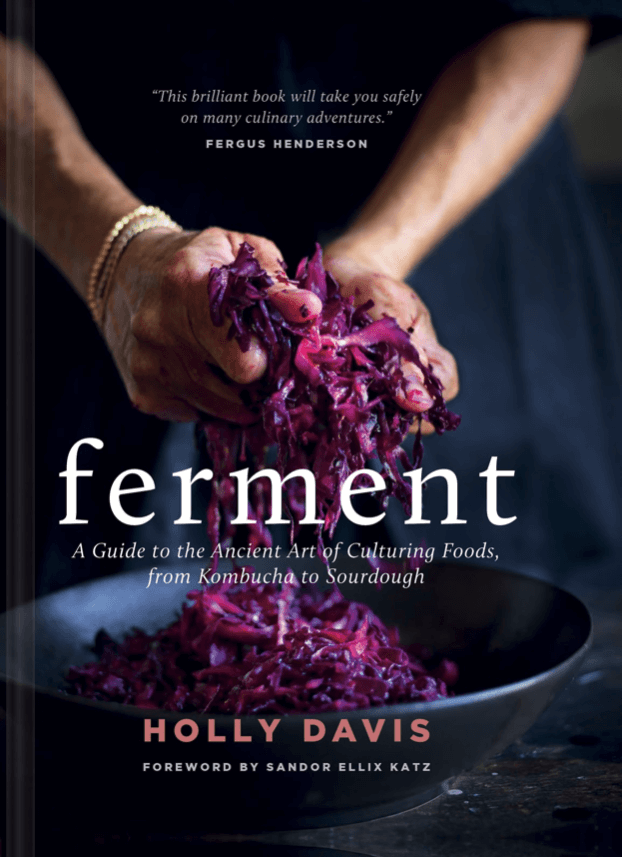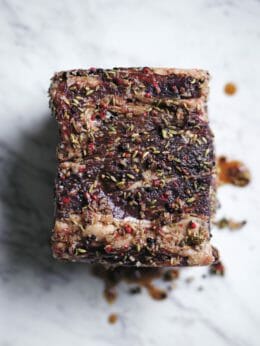Twice a month, our writer cooks from the book and decides if these farm-to-table recipes are worth the investment.

Fermentation is having a moment. Whether you just picked up some artisanal kombucha at the farmers’ market or invested in serious cheese-making equipment, chances are, you’ve been bitten by the probiotic bug. Ferment: A Guide to the Ancient Art of Culturing Foods, from Kombucha to Sourdough (Chronicle Books, $29.95), by Australian fermentation doyen Holly Davis, caters to both ends of the spectrum. While most books on the subject focus on either the molecular-science side of things or the very casual let-Mother-Earth-do-her-thing approach, Ferment occupies a happy middle ground. The book starts with the very basic technique of activating nuts and seeds by soaking and sprouting them and ramps up to culturing liquids naturally, pickling fruits and vegetables, baking leavened breads, curing meats and fish and making cheeses. Each chapter is organized from the most basic recipe to the most advanced version. But this isn’t just a textbook; you’ll find creative, modern recipes that make the most of these techniques. I doubt your grandma’s fermentation repertoire included Herb Booch Vinaigrette or Sweet and Sour Tender Ginger.
We love kimchi in this house, and I’ve made a stock-standard spicy cabbage version. But a mild white version? Never! Crisp White Radish Kimchi mixes a paste made from green onions, ginger, garlic, fish sauce, green apple and Asian pear with daikon radish that has been cubed, salted, pressed for an hour and rinsed. Everything is crammed into a scrupulously clean jar and left to ferment on the counter for at least seven days. The result is funky, crunchy kimchi that could take the place of sour dill pickles.
For anyone with even the slightest interest in culturing food, Ferment is worth the investment. Cautious newbies will appreciate Davis’s thorough explanations and calm, guiding voice, while advanced probiotic enthusiasts will discover new things to ferment and more advanced uses for their skills.
Wendy Underwood tests out cookbooks weekly on Instagram at @kitchenvscookbook.
Excerpted from Ferment by Holly Davis. Recipes Copyright © 2019. Excerpted by permission of Chronicle Books. All rights reserved.
Maple Fennel and Peppercorn Sirloin
Total time: 24 to 72 hours
Servings: 8 to 12 sliced thinly // 6 as steaks
Here, the seasoned salt and sugar mixture prevents the meat from oxidizing, while drawing out some moisture and adding flavor. The result is intensely delicious, semi-dried tender beef. The longer the beef is left to cure, the stronger the flavor and drier the texture. It is important to use the best quality of grass-fed sirloin beef you can find for this recipe.
- 2 lb 4 oz (1 kg) pasture-raised organic beef sirloin
- 1 ½ tablespoons mixed peppercorns, lightly crushed
- 8 ½ oz (240 g) coarse sea salt
- 4 ¼ oz (120 g) maple sugar or light brown muscovado sugar
- 1 ½ tablespoons fennel seeds
- 2 chilies, to taste (optional)
- Take a very clean nonreactive container in which to cure the meat – a small enamel baking tray works nicely.
- Trim the meat of any obvious sinew and most, but not all, of the fat capping. Leave the cap on if you will be searing and serving as steaks.
- Combine all the cure ingredients in a bowl.
- CURE Sprinkle half of the cure mixture in an even layer over the base of the container or tray and lay the beef on top, then cover with the remaining mixture and rub the cure into the beef, making sure to get it into all the crevices.
- Cover the beef with a sheet of parchment paper and weight down using a small plate with additional weight on top, such as a sealed jar filled with water. Place the weighted container in the fridge for 24–72 hours, turning the beef every 6 hours or so. The beef will firm up as it cures and releases liquid.
- Remove the beef from the cure, and brush off and discard as much of the cure as possible. Slice into wafer-thin pieces and eat as is or cut into thick slices ready to sear in a hot frying pan. Be sure to sear the fat cap well too, and don’t overcook the steaks.
White Kimchi Paste
Total time: 10 minutes
Servings: 1 3⁄4 CUPS (450 G)
- 1 bunch green onions (scallions)
- 1⁄4 cup (30 g) chopped ginger
- 6–8 garlic cloves, peeled
- 1 small green apple, peeled and cored
- 1 medium Asian pear, peeled and cored
- 4 tablespoons fish sauce (see note)
- Roughly chop the whites of the green onions and add to the bowl of a food processor or blender (save the greens for using in another recipe). Blitz all the kimchi ingredients together to make a smooth paste. Use right away, or ferment and store as above.
Note: In place of fish sauce, you can use the same quantity of fermented shrimp (saeu-jeot), or if making vegan kimchi, use 2 tablespoons sea salt.
Crisp White Radish Kimchi
Total time: 7 to 30 days
Servings: 6 cup (1.5 L) jar
When juicy and crunchy are what you seek, reach for a jar of this. Serve it in large chunks, or cut it to suit the dish it is accompanying. The green onions lose their color as the mix ferments, so you might prefer to use only the white part. These are quite white and gorgeous when made with the white kimchi paste.
- 1 large Korean or daikon radish, peeled and cut into 1 in (2.5 cm) dice
- 2 tablespoons sea salt
- 1⁄2 bunch green onions (scallions), cut into 1 in (2.5 cm) lengths
- 1 recipe red or white kimchi paste
- Put the radish and salt in a large bowl and combine. Use your hands to massage the salt into the radish, then place 2–3 plates on top as a weight (this will help draw out the moisture from the radish). Let sit for 1 hour.
- Drain the liquid into a jar for later use in vegetable juices or soups. Rinse the radish in cold water and drain well. Return the radish to the bowl, add the green onions and the red or white kimchi paste, then massage the paste into the radish.
- CAPTURE Fill a very clean jar with the radish and use your clean fist or a pestle to push out as much air as you can. Seal the jar with the lid and leave in a cool place to ferment for 7–30 days. Taste after day 7 and refrigerate when you are happy with the strength of flavor. Once in the fridge, this will keep for up to 12 months.

